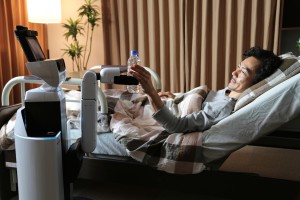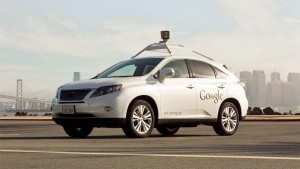
The new Toyota/Stanford/MIT project will focus not only on autonomous vehicles but robotics, including those for medical applications.
Toyota will invest $50 million in a new joint project with Stanford University and the Massachusetts Institute of Technology to advance the development of artificial intelligence, autonomous driving and robotics.
While the project could eventually lead to fully autonomous vehicles, the more immediate goal is to assist human drivers to be not only safer but also to allow them to drive later in life. The project also should have applications outside the automotive environment, stressed participants in the project during a news conference in Silicon Valley. Among other things, they hope to use robotics to allow people to live more independently, even in the latter years of life.
“We believe this research will transform the future of mobility, improving safety, reducing traffic congestion and improving the quality of life for everyone,” said Toyota Managing Office Kiyotaka Ise, who added, “It will extend well beyond cars.”
But Toyota clearly aims to advance the technology available to those buying its vehicles. The auto industry has entered a race to see who can provide the more advanced safety technologies and, longer-term, let vehicles take over the actual task of driving.
The potential benefits are significant, noted MIT Professor Daniela Rus, who oversees the university’s computer science department and who will be its leader in the collaboration. Rus noted that there is a motor vehicle crash in the U.S. every five seconds. In 2013, the latest year for which full data is available, over 32,000 Americans were killed in crashes, while the number topped 1 million worldwide.
“Just imagine if cars could learn how to drive?” she suggested. “What if cars could become trusted partners and cover our backs?”
(Stanford working with Cornell on system that could anticipate driver errors. Click Here for the full story.)
Toyota’s Ise cautioned that unlike some of its competitors, as well as tech giant Google, it does not believe fully autonomous vehicles will be the immediate solution, but rather that the industry will get there in “steps,” with the initial focus being on coming up with technology that can assist the driver into making safer, better decisions on the road and, if necessary, stepping in when a motorist becomes distracted or drowsy.
Automakers have been adding more and more semi-autonomous features to their vehicles each year. BMW, for example, will let a driver take hands off the wheel for up to 15 seconds when the new 7-Series sedan debuts for 2016. Tesla and Cadillac hope to offer the capability of driving even longer distances hands-free, though only on a well-marked, limited-access highway.
(Autonomous vehicle technologies coming to market faster and faster. Click Here for more.)
The challenges of autonomous technology have been underscored by the spate of crashes involving prototype Google cars. So far, of more than a dozen different accidents, all have been blamed on human error, rather than the technology. But, in some cases, it appears that by absolutely obeying all the rules – say, slamming on the brakes at a yellow light – the technology inadvertently may have at least contributed to the crashes.
That could be an example of “a mismatch in the behavior and expect of people in non-autonomous cars and the programming of the autonomous cars,” said Gill Pratt. The former director of the Defense Department’s DARPA Challenge, an autonomous vehicle competition, he has joined Toyota to oversee the new MIT/Stanford collaboration.
A key element of the project will be to better understand human behavior. In turn, that would allow artificial intelligence systems and robotics to more accurately understand and mimic what humans would do in a particular situation.
Beyond the automotive potential, the project will explore ways to use robots and other technologies to assist the elderly, both to let them drive, and to be able to live independently, later in life. Toyota recently introduced a new Human Services Robot, or HSR, that will be used to assist health care workers in various medical situations.
(For more on Toyota’s HSR, Click Here.)


Robots and AVs offer a lot of potential if they are properly designed and include all safety systems to compensate for command and component failures. The last thing an elderly person needs is to be stuck in an AV that breaks down in the middle of rush hour traffic in the heat or extreme cold weather. Life is challenging enough for the elderly without the stress and trauma of being stranded and helpless.
It should be noted that the accidents were caused by humans in other cars. Not the google vehicle.
Intriguing, DWH, that during yesterday’s news conference announcing a $50 mil Toyota joint venture with Stanford and MIT, the head of that project acknowledged there can be a “mismatch” between drivers and autonomous tech. If, for example, you program an autonomous system to absolutely slam the brakes the instant the light turns yellow you have a good chance that, at some point, you are going to get slammed from behind. Technically, the autonomous vehicle was obeying the law, but that’s a faint defense. One of the things the participants acknowledged is that AI systems (which includes autonomous tech) need to be better programmed to understand, and interact with, human behavior. It may mean pushing through a yellow at times, especially if the autonomous vehicle’s sensors show it is being tailgated.
Paul A. Eisenstein
Publisher, TheDetroitBureau.com
It’s already been demonstrated that AVs are no where near ready for real world use as they have inadequate programming and many other safety issues that need to be addressed. It would be far better to adjust all traffic lights in the U.S. to a standard timing sequence than to program an AV to drive through a yellow traffic light which is a violation in Michigan. With some people routinely driving through red lights it’s also going to cause an issue for AVs if they are unable to avoid these red light bandits talking on their cellphone or just ignoring the red traffic light.
There is an old and odd law in MI that if you enter an intersection when the light is yellow, it’s a violation and police do issue tickets for this. The law obviously needs to be changed as panics stops cause unnecessary vehicular accidents and injuries and also result in a traffic ticket in MI.
Google has reported that two accidents were caused by the AVs.
Just cause the other driver is an idiot is reason for everybody to drive like an idiot. Theres a saying among airplane pilots. There are old pilots. There are bold pilots. But there are no old and bold pilots.
In MI if you slam on the brakes and another car runs into the back of your car because you over reacted or stopped unnecessarily fast, you bear 50% of the responsibility for the accident and are cited for a traffic violation.
One day all cars will be AV’s and will talk to each other always knowing what the other one is doing. There will be no need for red lights then. The whole car network will be working together to get people from point A to point B but that day is still a long ways off.
That may be the goal but there will still be congestion and other issues that electronic communications can’t resolve. There may also be an issue with people who prefer to drive and refuse to have an AV or hands free model.